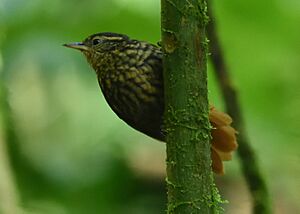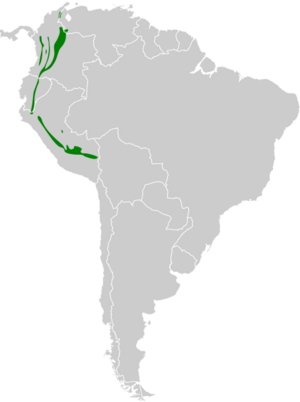Rusty-winged barbtail facts for kids
Quick facts for kids Rusty-winged barbtail |
|
|---|---|
 |
|
| Conservation status | |
| Scientific classification | |
| Genus: |
Premnornis
|
| Species: |
guttuliger
|
 |
|
| Synonyms | |
|
Premnornis guttuligera |
|
The rusty-winged barbtail (Premnornis guttuliger) is a small bird found in South America. It lives in countries like Colombia, Ecuador, Peru, and Venezuela. This bird is part of the ovenbird family called Furnariidae. It's known for its unique tail feathers.
Contents
About the Rusty-winged Barbtail
The rusty-winged barbtail is the only bird in its special group, or genus, called Premnornis. It has two slightly different types, or subspecies. One is called P. g. guttuliger, and the other is P. g. venezuelanus. These names help scientists keep track of different animal groups.
What Does It Look Like?
This bird is about 13 to 14.5 centimeters (5 to 5.7 inches) long. It weighs around 13 to 17 grams (0.46 to 0.6 ounces). Both male and female rusty-winged barbtails look very similar.
- Face: They have a light, pale stripe above their eye. A dark brown stripe goes behind their eye. The rest of their face has streaks of brown and light buff colors.
- Body: Their head is dark olive-brown. The sides of their neck and upper back are brownish with light spots. Their lower back is plain brown. Their rump is brownish with a hint of reddish-brown.
- Tail: Their tail is a reddish-brown color. The tail feathers are wide and end in short, stiff "barbs" or "spines." These "barbs" are actually parts of the feather shaft without the soft feather parts.
- Wings: Their wing feathers are dark brownish with reddish-brown edges. These edges can look like faint bars on their wings.
- Underparts: Their throat is a golden-buff color with tiny dark spots. Their chest is dark brownish with golden-buff "teardrop" shapes. Their belly is dark brownish with golden-buff streaks on the top half.
- Other features: Their eyes are brown. Their upper beak is dark, and their lower beak is pinkish or ivory. Their legs and feet are gray or pinkish-gray.
Young rusty-winged barbtails look a bit different. They have buff streaks on their back and rump. Their underparts have more spots and a reddish wash compared to adult birds. The subspecies P. g. venezuelanus has a darker, more olive-colored head and back than the other type.
Where Does It Live?
The main subspecies, P. g. guttuliger, lives in the Andes mountains. You can find it in Colombia, Ecuador, and Peru. Some maps show it in Bolivia, but scientists haven't officially recorded it there. The other subspecies, P. g. venezuelanus, lives near the border of Colombia and Venezuela. It also lives in the Andes mountains in Venezuela.
This bird likes to live in mountain forests that stay green all year. These forests are called subtropical montane evergreen forests. They usually live at heights between 1,400 and 2,700 meters (4,600 to 8,900 feet) in Colombia. In Ecuador, they are mostly found between 1,600 and 2,300 meters (5,200 to 7,500 feet). Sometimes, in Peru, they can be found as low as 1,300 meters (4,300 feet).
How Does It Behave?
The rusty-winged barbtail stays in the same area all year long. It does not migrate.
What Does It Eat?
This bird mostly eats small bugs and other creatures called arthropods. It usually feeds alone or sometimes in pairs. They often join groups of different bird species that are looking for food together. They search for food from the lower parts of the forest up to the middle levels. Sometimes, they even look in the higher tree branches.
They find their food by picking bugs off moss, dead leaves, and live plants. They hop and climb along branches. They also like to "burrow" or dig into clumps of moss to find hidden snacks.
Life Cycle and Reproduction
Scientists are still learning about when the rusty-winged barbtail breeds. It seems to be from August to December. These birds are thought to stay with one partner for life. Not much is known about their nests, but one nest was found with two eggs. We still have a lot to discover about how these birds raise their young.
Sounds and Calls
The rusty-winged barbtail doesn't sing very often. What is believed to be its song is a fast, quick sound that gets faster and faster. It sounds like "'tsi-tsi-tsi-si-si-sisisisisisi". Its call is a sharp "tseep" or "tsip." Sometimes, it repeats this call in a series.
Its Status in Nature
The International Union for Conservation of Nature (IUCN) says the rusty-winged barbtail is a species of "Least Concern." This means it's not currently in danger of disappearing. It lives across a large area. We don't know exactly how many there are, but their numbers seem to be stable. There are no immediate threats to this bird right now. It's considered uncommon in some places but common in others. It also lives in some protected areas, which helps keep it safe.


